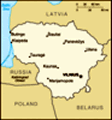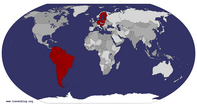Advertisement
After Estonia and Latvia, I arrived in the final Baltic state of Lithuania. I was heading to the country’s small coastline and Lithuania’s third largest city, Klaipéda, but I stopped along the way at the fourth city, Siaulai (more or less pronounced Shoo-lay). This industrial city doesn’t really have anything to detain the visitor for that long, but 10km outside Siaulai is what has been described as the most “awe inspiring sight in Lithuania”, namely Siaulai’s Hill of Crosses. Essentially there are 2 small hills which, over many years, Lithuanians have taken to putting crosses in. There are more than 200,000 crosses there now, of all sizes. I was amazed at how many people were actually at the site when I visited – I assumed something so obscure and essentially in the middle of nowhere would be deserted – but in fact it was jammed, with coaches in the car park from as far away as France. The hill did seem a bit eerie to me, but then it probably means more to Lithuanians as placing crosses on the hill was one of the country’s ways to peacefully resist against the Soviet regime. I probably wouldn’t have come here if I
hadn’t have had to pass through Siaulai, but it served as a good introduction to Lithuania, underlining from the first how this country is strongly Catholic, unlike protestant Latvia and Estonia (incidentally Estonia is the most atheist country in the world).
From Siaulai I continued towards Klaipéda, on possibly the world’s slowest bus (or more accurately, the world’s least direct bus service). I eventually got to Klaipéda quite late in the evening, and didn’t really get a chance to see the city until the following day. Klaipéda, the oldest city in Lithuania, was known as Memel up until 1918 and was the easternmost point in Germany. When the Soviets drove out the Nazis towards the end of WW2, there were amazingly only 8 survivors left in the city (!), with most of the native German population having retreated with the German army. As such, the city doesn’t really have that much of a German feel anymore. Actually, it turned out to be a bit of a nothing city – there was really very little of interest in the city whatsoever. The biggest attraction is the Theatre Square, featuring a balcony where Hitler once addressed the people of the city.
And even that was behind scaffolding whilst I was there. So the city as a whole was rather disappointing. It’s one redeeming feature – and it really did make a world of difference – is its proximity to the Curonian Spit, which is one of the most beautiful parts of Lithuania. The spit is 100km long and 4km wide and spurs into the Baltic Sea, connected by land only to Russia (Kaliningrad/Konigsberg). But the end of the spit virtually touches Klaipéda – and a 5 minute ferry regularly makes the crossing. The spit was undeniably beautiful – lovely sandy beaches, majestic sand dunes, pine forests and some charming small towns (partially German-speaking) as well. Nida, which lies on the border with Russia was definitely the most interesting and the most picturesque. Very windy though – one cyclist got too close to the harbour edge and actually got blown in! (He was okay though).
25km to the other side of Klaipéda, towards the Latvian border, is Lithuania’s only seaside resort, Palanga. This was a definite mixture of shabby and chic, with upmarket resorts near to the usual tacky seaside array of amusements and fast food. As it is the only
resort in Lithuania, it was incredibly busy (given that it was a weekday), but then the beaches were beautiful.
From Klaipéda, I headed inland towards the capital, Vilnius. I decided to stop off in the country’s second city, Kaunas, for one night to see if it compared positively to Klaipéda. Kaunas probably isn’t really on that many tourists’ itineraries, but I actually really liked the city. It had a really nice old town, situated right at the confluence of Lithuania’s two longest rivers, and included the usual castle, cathedral and several other churches. As Kaunas was the capital of Lithuania in the interwar period (as Vilnius was occupied by the Poles), there was no shortage of grand buildings that once served as the Presidential Palace and Parliament for example. Outside the old town, a long Parisian-style boulevard stretches eastwards towards the domed St Michael’s Church, filled with high-end boutique shops. So all things considered, Kaunas really struck me as a nice city; certainly infinitely more pleasant than Klaipéda.
My last stop in Lithuania, Vilnius, was just 90 minutes from Kaunas by train. Like the other Baltic capitals, it has a UNESCO world heritage Old Town, but unlike Riga
and Tallinn, it isn’t a mega tourist destination just yet. That said, I did really like the old town. The city enjoys a rich and diverse architecture, centred around the dozen or so churches that are dotted around the centre, including the Greco-roman Cathedral with its standalone Belfry. There seemed to be a church visible on almost every street, but then again this is a highly Catholic country. Unlike Tallinn, there isn’t much left of the original city walls; the one remaining gate, known as “The Gates of Dawn” has been converted to a rather over ornate chapel. One of the best view points over the city was from a hill with three crosses, just to continue the religious theme, but the best views were actually from the castle, which sits on a hill adjacent to the cathedral. The castle itself isn’t much to look at – mostly in ruins, except for one tower which has been rebuilt, but the panoramic view from the top of the tower made the climb from the Cathedral Square below worth it. The main square and the main restaurant street felt so much quieter when compared to Riga or Tallinn – everything seemed to
close a lot earlier, which made the city feel more like a provincial market town rather than the capital city, but I did appreciate the fact the city was a lot more peaceful and less crowded than the other Baltic capitals.
Whilst in Vilnius, I visited a couple of sites outside of the city; the first was the one time capital of Lithuania, Trakai. This small town is located between 2 lakes; these, coupled with its two castles, made it quite a beautiful place, and absolutely jammed with tourists. I preferred Sigulda near Riga, but the Lithuanians clearly love Trakai – I saw at least a dozen brides walking around the castle grounds having photos taken (it was a Saturday). The most interesting thing I saw in the town was a tournament of canoe polo, which is not a sport I had ever heard of before, let alone seen. Essentially a cross between basketball, canoeing and polo, which proved quite interesting to watch.
The other site just outside of Vilnius couldn’t be more different from Trakai. Paneraia, just 10km from Vilnius, was the site of a Nazi death camp, where, in 1944, over 100,000 people died. In contrast
to busy Trakai, there was no-one at all at Paneraia (I did visit in the middle of torrential rain to be fair), but it’s not even sign posted from the nearby station and not advertised in Vilnius. Bearing in mind that half of Vilnius’s population was murdered here, you would think the Lithuanians would do more to remember. As it was, Paneraia was a hauntingly quiet site, situated in serene pine forests, with the remnants of pits the only evidence of the atrocities that took place here. An incredibly thought provocative place as you can imagine.
Food in the Baltic states was interesting shall we say – I didn’t really see that much difference between the three countries, with potato, meat and smoked fish being the main staples throughout the region. They seem to like their food very bland, so wasn’t really to my taste. But with the world being so globalised, international cuisine was of course readily available everywhere.
Besides the food, there were a few aspects of Lithuania that I didn’t like. Firstly, a lot of the people I met came across as being very rude and abrupt, and certainly were not always that friendly and
helpful. Estonians were very much introvert, but were always helpful when I spoke to them; Latvians were much more outgoing and always friendly. I did meet a lot of great Lithuanians, but there were quite a few whom, when realising I was obviously a foreigner, became very nonchalant, bordering on being impolite. I met a Pakistani at one of the hostels who had come across behaviour bordering on racism; possibly not surprising given that the population is nearly 100% Caucasian.
So having spent just over 2 weeks in the 3 Baltic nations, I’m ready to move on, and I more or less feel that I saw everything that was worth seeing in the three countries. For me Riga was definitely the stand out city, and Latvia probably the most enjoyable country, though they are all pretty similar. I’m now heading for Poland – catch my next blog from there.
Advertisement
Tot: 0.159s; Tpl: 0.013s; cc: 7; qc: 47; dbt: 0.1223s; 1; m:domysql w:travelblog (10.17.0.13); sld: 1;
; mem: 1.2mb























Nel Kanas
non-member comment
Travelling the Baltics
I stumbled across your blog and was delighted at the amount of time you have saved me in research, as I had planned to do exactly your trip but in reverse. Your honesty was refreshing and without prejudice, you wrote clearly and well, your keen observations were exactly the sort of things I was trying to find out. Thank you very much.